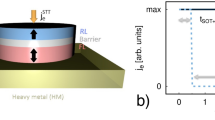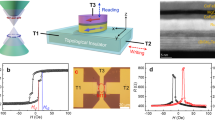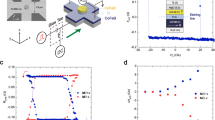Abstract
Current-induced spin-transfer torques (STT) and spin–orbit torques (SOT) enable the electrical switching of magnetic tunnel junctions (MTJs) in non-volatile magnetic random access memories. To develop faster memory devices, an improvement in the timescales that underlie the current-driven magnetization dynamics is required. Here we report all-electrical time-resolved measurements of magnetization reversal driven by SOT in a three-terminal MTJ device. Single-shot measurements of the MTJ resistance during current injection reveal that SOT switching involves a stochastic two-step process that consists of a domain nucleation time and propagation time, which have different genesis, timescales and statistical distributions compared to STT switching. We further show that the combination of SOT, STT and the voltage control of magnetic anisotropy leads to reproducible subnanosecond switching with the spread of the cumulative switching time smaller than 0.2 ns. Our measurements unravel the combined impact of SOT, STT and the voltage control of magnetic anisotropy in determining the switching speed and efficiency of MTJ devices.
This is a preview of subscription content, access via your institution
Access options
Access Nature and 54 other Nature Portfolio journals
Get Nature+, our best-value online-access subscription
$29.99 / 30 days
cancel any time
Subscribe to this journal
Receive 12 print issues and online access
$259.00 per year
only $21.58 per issue
Buy this article
- Purchase on Springer Link
- Instant access to full article PDF
Prices may be subject to local taxes which are calculated during checkout





Similar content being viewed by others
Data availability
The data that support the plots within this paper and other findings of this study are available from the corresponding author upon reasonable request.
References
Brataas, A., Kent, A. D. & Ohno, H. Current-induced torques in magnetic materials. Nat. Mater. 11, 372–381 (2012).
Kent, A. D. & Worledge, D. C. A new spin on magnetic memories. Nat. Nanotechnol. 10, 187–191 (2015).
Manchon, A. et al. Current-induced spin–orbit torques in ferromagnetic and antiferromagnetic systems. Rev. Mod. Phys. 91, 035004 (2019).
Ralph, D. C. & Stiles, M. D. Spin transfer torques. J. Magn. Magn. Mater. 320, 1190–1216 (2008).
Apalkov, D., Dieny, B. & Slaughter, J. M. Magnetoresistive random access memory. IEEE Proc. 104, 1796–1830 (2016).
Hanyu, T. et al. Standby-power-free integrated circuits using MTJ-based VLSI computing. IEEE Proc. 104, 1844–1863 (2016).
Krivorotov, I. N. et al. Time-domain measurements of nanomagnet dynamics driven by spin-transfer torques. Science 307, 228–231 (2005).
Liu, H. et al. Dynamics of spin torque switching in all-perpendicular spin valve nanopillars. J. Magn. Magn. Mater. 358–359, 233–258 (2014).
Devolder, T. et al. Single-shot time-resolved measurements of nanosecond-scale spin-transfer induced switching: stochastic versus deterministic aspects. Phys. Rev. Lett. 100, 057206 (2008).
Cui, Y. T. et al. Single-shot time-domain studies of spin-torque-driven switching in magnetic tunnel junctions. Phys. Rev. Lett. 104, 097201 (2010).
Devolder, T. et al. Time-resolved spin-torque switching in MgO-based perpendicularly magnetized tunnel junctions. Phys. Rev. B 93, 024420 (2016).
Devolder, T., Le Goff, A. & Nikitin, V. Size dependence of nanosecond-scale spin-torque switching in perpendicularly magnetized tunnel junctions. Phys. Rev. B 93, 224432 (2016).
Hahn, C. et al. Time-resolved studies of the spin-transfer reversal mechanism in perpendicularly magnetized magnetic tunnel junctions. Phys. Rev. B 94, 214432 (2016).
Tomita, H. et al. Single-shot measurements of spin-transfer switching in CoFeB/MgO/CoFeB magnetic tunnel junctions. Appl. Phys. Express 1, 061303 (2008).
Bultynck, O. et al. Instant-on spin torque in noncollinear magnetic tunnel junctions. Phys. Rev. Appl. 10, 054028 (2018).
Heindl, R., Rippard, W. H., Russek, S. E. & Kos, A. B. Physical limitations to efficient high-speed spin-torque switching in magnetic tunnel junctions. Phys. Rev. B 83, 054430 (2011).
Miron, I. M. et al. Perpendicular switching of a single ferromagnetic layer induced by in-plane current injection. Nature 476, 189–193 (2011).
Garello, K. et al. Symmetry and magnitude of spin–orbit torques in ferromagnetic heterostructures. Nat. Nanotechnol. 8, 587–593 (2013).
Lee, S.-W. & Lee, K.-J. Emerging three-terminal magnetic memory devices. IEEE Proc. 104, 1831–1843 (2016).
Liu, L. et al. Spin-torque switching with the giant spin Hall effect of tantalum. Science 336, 555–558 (2012).
Fukami, S., Anekawa, T., Zhang, C. & Ohno, H. A spin–orbit torque switching scheme with collinear magnetic easy axis and current configuration. Nat. Nanotechnol. 11, 621–625 (2016).
Cubukcu, M. et al. Spin–orbit torque magnetization switching of a three-terminal perpendicular magnetic tunnel junction. Appl. Phys. Lett. 104, 042406 (2014).
Cubukcu, M. et al. Ultra-fast perpendicular spin–orbit torque MRAM. IEEE Trans. Magn. 54, 1–4 (2018).
Wang, M. et al. Field-free switching of a perpendicular magnetic tunnel junction through the interplay of spin–orbit and spin-transfer torques. Nat. Electron. 1, 582–588 (2018).
Garello, K. et al. SOT-MRAM 300MM integration for low power and ultrafast embedded memories. IEEE Symposium on VLSI Circuits https://ieeexplore.ieee.org/document/8502269 (2018).
Lee, K.-S., Lee, S.-W., Min, B.-C. & Lee, K.-J. Threshold current for switching of a perpendicular magnetic layer induced by spin Hall effect. Appl. Phys. Lett. 102, 112410 (2013).
Garello, K. et al. Ultrafast magnetization switching by spin–orbit torques. Appl. Phys. Lett. 105, 212402 (2014).
Zhang, C., Fukami, S., Sato, H., Matsukura, F. & Ohno, H. Spin–orbit torque induced magnetization switching in nano-scale Ta/CoFeB/MgO. Appl. Phys. Lett. 107, 012401 (2015).
Aradhya, S. V., Rowlands, G. E., Oh, J., Ralph, D. C. & Buhrman, R. A. Nanosecond-timescale low energy switching of in-plane magnetic tunnel junctions through dynamic Oersted-field-assisted spin Hall effect. Nano Lett. 16, 5987–5992 (2016).
Baumgartner, M. et al. Spatially and time-resolved magnetization dynamics driven by spin–orbit torques. Nat. Nanotechnol. 12, 980–986 (2017).
Decker, M. M. et al. Time resolved measurements of the switching trajectory of Pt/Co elements induced by spin–orbit torques. Phys. Rev. Lett. 118, 257201 (2017).
Yoon, J. et al. Anomalous spin–orbit torque switching due to field-like torque-assisted domain wall reflection. Sci. Adv. 3, 1603099 (2017).
Sampaio, J. et al. Time-resolved observation of fast domain-walls driven by vertical spin currents in short tracks. Appl. Phys. Lett. 103, 242415 (2013).
Garello, K. et al. Manufacturable 300 mm platform solution for field-free switching SOT-MRAM. IEEE Symposium on VLSI Technology https://doi.org/10.23919/VLSIT.2019.8776537 (2019).
Pai, C.-F. et al. Spin transfer torque devices utilizing the giant spin Hall effect of tungsten. Appl. Phys. Lett. 101, 122404 (2012).
Sun, J. Z. et al. Effect of subvolume excitation and spin-torque efficiency on magnetic switching. Phys. Rev. B 84, 064413 (2011).
Chaves-O’Flynn, G. D., Wolf, G., Sun, J. Z. & Kent, A. D. Thermal stability of magnetic states in circular thin-film nanomagnets with large perpendicular magnetic anisotropy. Phys. Rev. Appl. 4, 024010 (2015).
Martinez, E. et al. Universal chiral-triggered magnetization switching in confined nanodots. Sci. Rep. 5, 10156 (2015).
Mikuszeit, N. et al. Spin–orbit torque driven chiral magnetization reversal in ultrathin nanostructures. Phys. Rev. B 92, 144424 (2015).
Weisheit, M. et al. Electric field-induced modification of magnetism in thin-film ferromagnets. Science 315, 349–351 (2007).
Maruyama, T. et al. Large voltage-induced magnetic anisotropy change in a few atomic layers of iron. Nat. Nanotechnol. 4, 158–161 (2009).
Wang, Z., Zhao, W., Deng, E., Klein, J.-O. & Chappert, C. Perpendicular-anisotropy magnetic tunnel junction switched by spin-Hall-assisted spin-transfer torque. J. Phys. D 48, 065001 (2015).
Kato, Y. et al. Improvement of write efficiency in voltage-controlled spintronic memory by development of a Ta–B spin Hall electrode. Phys. Rev. Appl. 10, 044011 (2018).
Yoda, H. et al. High-speed voltage-control spintronics memory (high-speed VoCSM). IEEE International Memory Workshop https://doi.org/10.1109/IMW.2017.7939085 (2017).
Zhu, J. et al. Voltage-induced ferromagnetic resonance in magnetic tunnel junctions. Phys. Rev. Lett. 108, 197203 (2012).
Thomas, L. et al. Perpendicular spin transfer torque magnetic random access memories with high spin torque efficiency and thermal stability for embedded applications (invited). J. Appl. Phys. 115, 172615 (2014).
Donahue, M. J. & Porter, D. G. OOMMF User’s Guide Version 1.0 Interagency Report NISTIR 6376 (National Institute of Standards and Technology, 1999).
Rohart, S. & Thiaville, A. Skyrmion confinement in ultrathin film nanostructures in the presence of Dzyaloshinskii–Moriya interaction. Phys. Rev. B 88, 184422 (2013).
Lee, K.-M., Choi, J. W., Sok, J. & Min, B.-C. Temperature dependence of the interfacial magnetic anisotropy in W/CoFeB/MgO. AIP Adv. 7, 065107 (2017).
Moreno, R. et al. Temperature-dependent exchange stiffness and domain wall width in Co. Phys. Rev. B 94, 104433 (2016).
Acknowledgements
This work was funded by the Swiss National Science Foundation (Grant no. 200020-172775), ETH Zurich (Career Seed Grant SEED-14 16-2) and imec’s Industrial Affiliation Program on STT-MRAM devices.
Author information
Authors and Affiliations
Contributions
E.G., K.G. and P.G. planned the experiments. S.C., F.Y. and K.G. designed and fabricated the samples. E.G. implemented the time-resolved electrical set-up. E.G. and V.K. performed the measurements. G.S. and V.K. performed the micromagnetic simulations. E.G., V.K, K.G. and P.G. analysed the results. E.G. and P.G. wrote the manuscript. All the authors discussed the data and commented on the manuscript.
Corresponding authors
Ethics declarations
Competing interests
The authors declare no competing interests.
Additional information
Peer review information Nature Nanotechnology thanks Christian Back, Andrew Kent and the other, anonymous, reviewer(s) for their contribution to the peer review of this work.
Publisher’s note Springer Nature remains neutral with regard to jurisdictional claims in published maps and institutional affiliations.
Extended data
Extended Data Fig. 1
Equivalent resistance setup of a three-terminal MTJ.
Extended Data Fig. 2 Comparison of the critical voltage for zero and small STT bias.
Critical switching voltage Vc as a function of pulse length τp for x = 0.46 (VSTT = 0) and x = 0.63 (minimum VSTT required to perform time-resolved measurements). The overlap of the data indicates no noticeable effect of the small STT bias on the SOT switching.
Extended Data Fig. 3
Schematic of the acquisition and normalization protocol for P-AP switching.
Extended Data Fig. 4 Examples of VP, VP-AP, VAP-P, and VAP time traces.
a, VAP, VAP-P and VP for AP-P SOT switching. b, Corresponding switching and reference signals, VAP-P-VAP, and VP-VAP, respectively. c, VP, VP-VAP, and VAP for P-AP STT switching. d, Corresponding switching and reference signals, VP-AP-VP and VAP-VP, respectively. The traces are averaged over 5000 (500) SOT (STT) switching events. These signals are used to obtain the normalized time traces shown in Fig. 2a,b for SOT and STT switching, respectively.
Extended Data Fig. 5 Average SOT and STT switching times as a function of pulse amplitude and in-plane field.
a,b, Comparison of the average incubation time and transition time for P-AP SOT switching as a function of pulse amplitude (VSOT > 0) at μ0Hx = −23 mT (a) and in-plane field μ0Hx at VSOT = + 453 mV (b). c,d, Comparison of the average incubation time and transition time for P-AP STT switching as a function of pulse amplitude (VSST > 0) at μ0Hx = –23 mT (c) and in-plane field μ0Hx at VSTT = +756 mV (d). In b,d, the pulse amplitude is the minimum allowing 100% switching (Psw = 1) at μ0Hx = −23 mT.
Extended Data Fig. 6 Single-shot measurements of SOT and STT switching in the AP-P case.
a,b, Representative time traces recorded during ten individual SOT-induced AP-P switching events induced by 15 ns long pulses with VSOT= +453 mV and increasing STT bias VSTT= −227, +266, +513 mV at a, μ0Hx= +23 mT and b, μ0Hx= +90 mT. c,d, Representative time traces recorded during ten individual STT-induced AP-P switching events at VSTT= +884 mV and c, μ0Hx= +23 mT and d, μ0Hx= 0 mT. The pulse amplitudes are the minimum ones required to achieve 100% switching in any of the shown configurations. The time traces have been vertically offset for clarity. Black solid lines are fits with a linear ramp used for extracting t0 and Δt. e, Statistical distributions of the incubation time t0, f, the transition time Δt and g, the total switching time t0+Δt at μ0Hx= +23 mT for SOT switching at different STT biases . h, Statistical distributions of t0, i, Δt and j, t0+Δt at μ0Hx= +90 mT. The histograms are obtained from the analysis of 1000 single-shot switching events.
Extended Data Fig. 7 Single-shot measurements of P-AP switching for different VSOT and Hx.
a-d, Representative time traces recorded during ten individual SOT-dominated P-AP switching events induced by 15 ns long pulses with a,b, VSOT= +453 mV, VSTT= −227 mV and c,d, VSOT= +481 mV, VSTT= −242 mV at a,c, μ0Hx= −23 mT and b,d, μ0Hx= −90 mT. The time traces have been offset for clarity. Black solid lines are fits with a linear ramp used for extracting t0 and Δt. e-h, Distributions of e, t0 and f, Δt at μ0Hx= −23 mT, and g, t0 and h, Δt at μ0Hx= −90 mT. The histograms are obtained from the analysis of 1000 single-shot switching events.
Extended Data Fig. 8 Combined effect of voltage control of magnetic anisotropy and STT on SOT-induced switching for the free layer initially pointing down.
a,b, Schematics of the SOT-dominated switching mechanism for the reference layer pointing a, up and b, down. Black arrows indicate the directions of rf currents, white arrows indicate the magnetization state. The STT (red arrow) given by VSTT either a, opposes or b, assists the SOT switching induced by VSOT (yellow arrow). c, Averaged time traces of SOT-induced AP-P switching with VSTT= −197, +73, +232, +447 mV for VSOT= +394 mV and τp=20 ns. d, Evolution of the critical voltage as a function of pulse length for different STT contributions as given by the VSTT/VSOT ratio. e, Normalized critical voltages \({v}_{\mathrm{c}}^ \uparrow\) and \({v}_{\mathrm{c}}^ \downarrow\) as a function of inverse pulse length for different VSTT/VSOT ratios. The magnetization of the reference layer points either up (\({v}_{\mathrm{c}}^ \uparrow\)) or down (\({v}_{\mathrm{c}}^ \downarrow\)), corresponding to the situation depicted in a, and b, respectively. Evolution of f, the average critical voltage \(\bar{{v}}_{\mathrm{c}}\) (VCMA-like contribution) and g, voltage asymmetry Δvc (STT-like contribution) as a function of VSTT/VSOT for short and long pulses. All measurements are performed at μ0Hx= +90 mT, VSOT>0 and correspond to AP-P (respectively P-AP) switching for the reference layer pointing up (down) and free layer initially pointing down.
Supplementary information
Supplementary Information
Supplementary Notes 1–3, Fig. 1, Table 1 and refs. 1–8.
Rights and permissions
About this article
Cite this article
Grimaldi, E., Krizakova, V., Sala, G. et al. Single-shot dynamics of spin–orbit torque and spin transfer torque switching in three-terminal magnetic tunnel junctions. Nat. Nanotechnol. 15, 111–117 (2020). https://doi.org/10.1038/s41565-019-0607-7
Received:
Accepted:
Published:
Issue Date:
DOI: https://doi.org/10.1038/s41565-019-0607-7
This article is cited by
-
Single-nanometer CoFeB/MgO magnetic tunnel junctions with high-retention and high-speed capabilities
npj Spintronics (2024)
-
Field-free spin–orbit torque switching in ferromagnetic trilayers at sub-ns timescales
Nature Communications (2024)
-
Inverse chirality-induced spin selectivity effect in chiral assemblies of π-conjugated polymers
Nature Materials (2024)
-
Spin-orbit torque efficiency enhancement to tungsten-based SOT-MTJs by interface modification with an ultrathin MgO
Science China Information Sciences (2024)
-
Spinel ferrites for resistive random access memory applications
Emergent Materials (2024)



